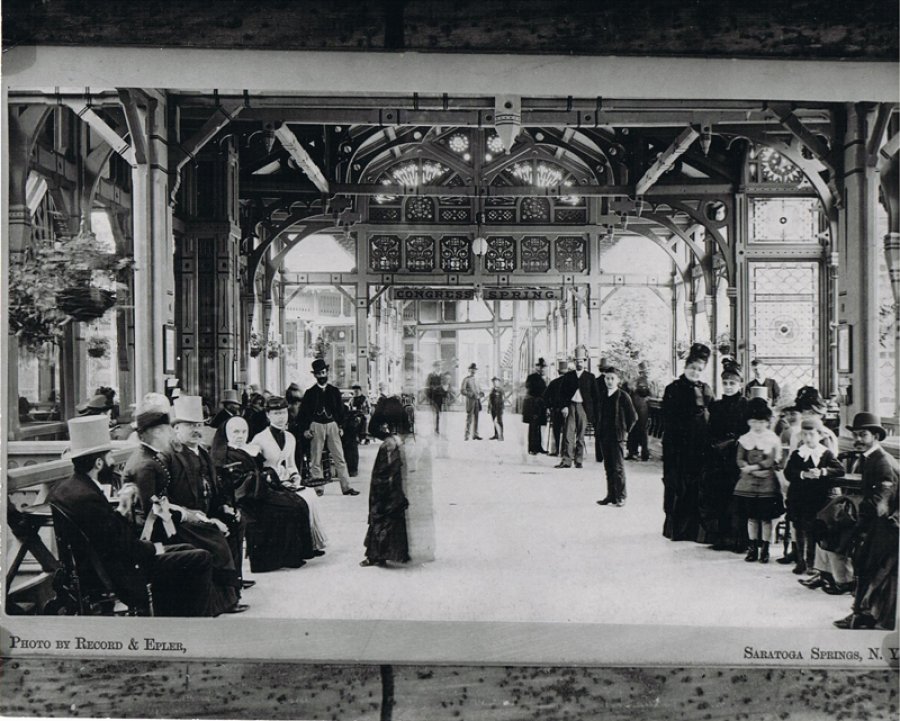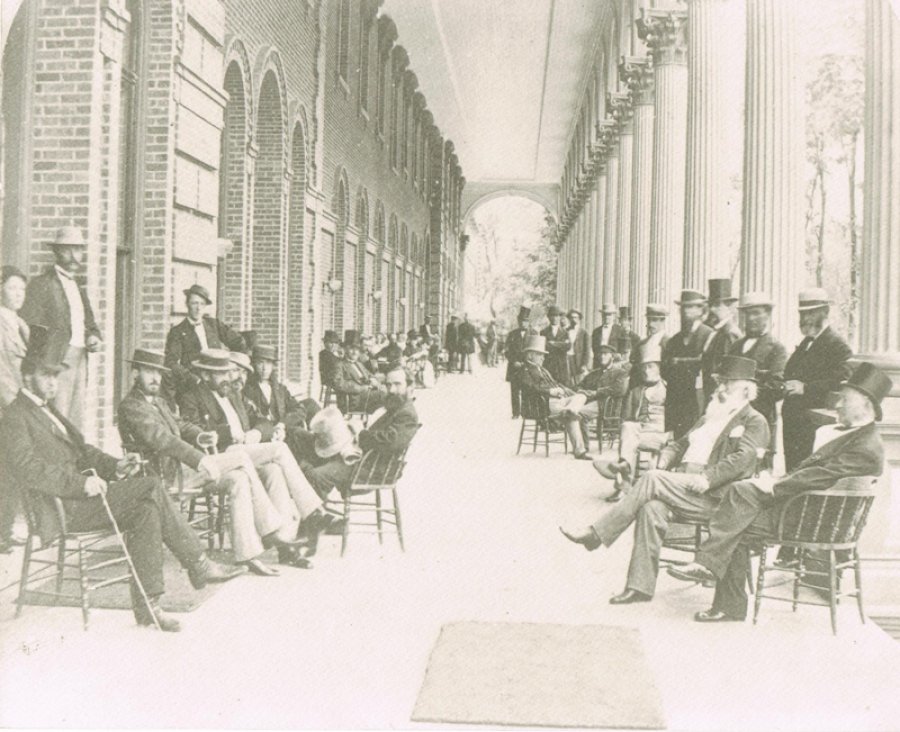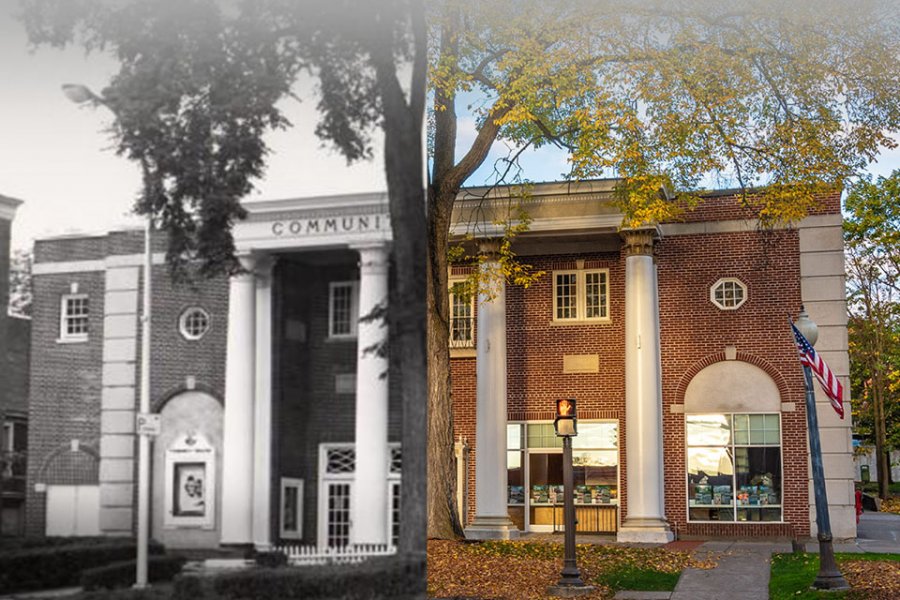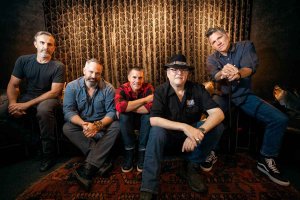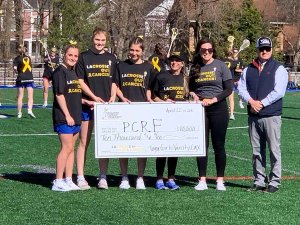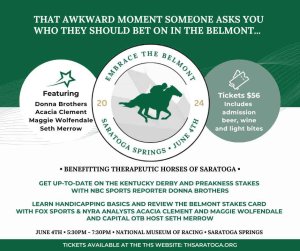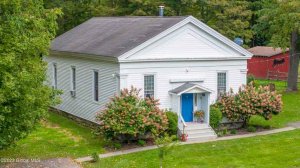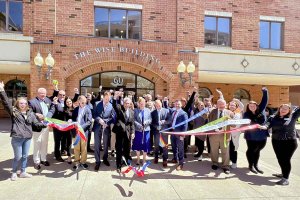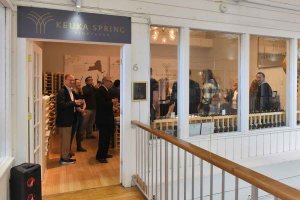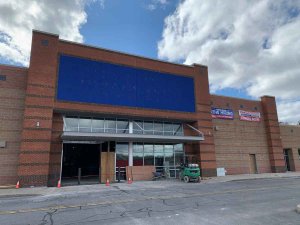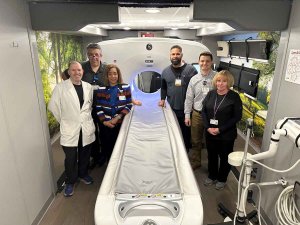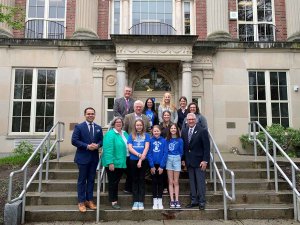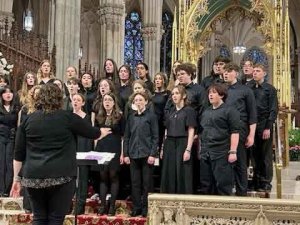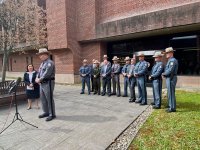Displaying items by tag: saratoga springs
History of Saratoga - Geology of the Mineral Springs
To truly understand the beginning of Saratoga Springs as a village you must understand the importance of the mineral springs in our development. A real understanding of the mineral springs is anchored in the understanding of the local geology.
Most people that visit the city today are not huge fans of the taste of the mineral springs when they try them for the first time. Having grown up in Saratoga Springs, my family and I always loved the taste of the springs, but I understand mineral water has a taste that you need to get accustomed to before saying you enjoy it, if ever. In 2019 some people say they only like the spring that dispenses water near the Auto Museum in the Spa State Park. That spring is not an example of a true deep sourced mineral spring in the city but rather a fresh water spring that draws its water from the upper hundred feet of another aquifer.
In order to better understand the deep sourced true mineral springs, we need look at the geologic history and therefore go back millions of years in Earth history. Approximately 490 million years ago the area around Saratoga looked very different than it does today. We were covered by a beautiful tropical ocean basin that became shallower as you traveled to the west toward Galway to eventually form the shoreline of this ocean and as you moved east toward Vermont it got deeper. Mountains further to the west were eroding with streams and rivers bringing sediment from that erosion process to the ocean for deposition. These deposited sediments would eventually harden to make varieties of sedimentary rock that would cover this entre area. Rock types like sandstone, limestone, dolomite, and shale were all deposited over millions of years in very thick layers in the Saratoga area. Most of these sedimentary rock types will hold rain water in their layers and act as a storage system or aquifer in the ground. The last layer to be deposited was a layer of black shale. Shale is a non-porous rock that will act as a protective cap over the other layers below.
This deposition process was stopped when the ocean receded as the area rose in elevation. Over millions of years as tectonic forces in the earth’s crust pushed on the rock layers it caused earthquakes to fracture those rock layers. Those fractures can be found as faults all around Saratoga. A very large fault called the McGregor Fault produced Mt. McGregor and continued south and branched to form the Saratoga Fault which is the main geologic fault running through the city that produced the mineral springs. The Saratoga Fault is categorized as a “normal” geologic fault. To understand a normal fault, picture a large block of material that is under pressure and breaks in the middle to produce two separate pieces. Then picture one of the two pieces rising and the other sinking down relative to the break or crack. This is the shape of a “normal” fault. Now picture Broadway in Saratoga Springs. The break or fault runs the length of the street. The break caused the west side including Broadway to rise and the east side to sink relative to each other. As a result, we see all the streets on the east side of Broadway such as Lake Avenue, Caroline Street, Phila and Spring Streets all go down in elevation from Broadway, therefore go down the face of the fault. This displacement is best seen in the rock cliff found in High Rock Park behind the 9/11 Memorial. Because of this fault all mineral springs are found on the east side of the fault.
This fault provided the break in the rock layers to allow the water trapped in those rock layers to rise to the surface as natural mineral springs. The Mohawk enjoyed the waters from these naturally occurring springs for hundreds of years before European settlers arrived with the technology to drill more mineral springs. By 1900 we had reached an apex in the number of springs in the city of Saratoga Springs with the number at 203. Many of these springs were pumped to extract carbon dioxide gas from the water for use in soda fountains in big cities. This abuse caused many of the original springs in the city to go dry. State laws passed in 1908 restricted the use and number of mineral springs to just 17 today. This restricted number allowed the aquifer over time to build back the necessary ground storage to provide for a stable supply for future use.
Many geologists today have wrestled with the analysis of why the mineral springs of Saratoga Springs are so unique. Our mineral springs are some of the highest naturally carbonated waters found in North American as well as some of the most highly mineralized “cold” water springs on the continent. The problem of carbonation has not been solved. The source of carbon dioxide gas is hotly debated but not resolved. Some claim the gas is from very deep-seated volcanic sources, while some think it’s a chemical process that provides it.
In the area of mineral content, we know heat helps to dissolve material in water as seen in cooking or in “hot springs.” Because our waters are cold and emerge from the ground at a consistent temperature of 52-54 degrees Fahrenheit year-round, that also presents a problem for discussion. While coming to the surface cold, the mineral water brings with it very large amounts of dissolved minerals from the ancient rock layers below. These minerals are what gives the Saratoga mineral springs their unique taste and possible health benefits. Our waters contain trace amounts of iron, iodine, cobalt, lithium, chromium, zinc, calcium and magnesium as well as many electrolytes. Our mineral waters do not contain sulfur in any reasonable amount and therefore cannot be identified as sulfur water.
Yes, our mineral water is unique and probably not in high demand because of its taste, but it helped to supply a need for visitors in the 1800’s. It was mineral water that acted as the spark that brought people to our city and helped it to become the number one resort in the United States in the 19th century.
City Democratic Committee Elects New Chair
SARATOGA SPRINGS – Several members of the Saratoga Springs Democratic Committee staged a walk-out last week, voicing their opposition to a candidate chosen by city voters for a seat on the City Council.
In this summer’s Democratic Primary for the party’s representation for Commissioner of Finance. challenger Patty Morrison defeated incumbent Michele Madigan by a 736-705 vote count. The city Democratic Committee (SSDC) had endorsed Madigan prior to the primary.
“We are resigning because we are unable to support Ms. Morrison for the position of Commissioner of Finance,” announced Charles Brown during an Aug. 1 press conference at High Rock Park, flanked by nearly a dozen others who presented themselves as resigning members of the SSDC.
“We cannot support Patty Morrison for this position and stay on in the Committee,” Brown said, adding the resigning members believe Morrison “unqualified and ill-suited” for the office. “We’re all strong lifelong Democrats and plan to be Democrats, but we are Democrats that are independent of party (now), meaning therefore we can support a candidate without crossing the dictate of the party.”
The resignations follow last month’s walk-out of five members who served on the SSDC Executive Committee.
Morrison countered that what matters most is the voice of resident city voters. “Saratoga Springs citizens have spoken and the message is clear -- from what was said at the doors and most importantly at the ballot box in the recent election -- we are not happy with the current Commissioner of Finance, poor decisions at the Council table and we ultimately voted for change,” Morrison said in a statement.
Morrison - on the Democratic line, and Madigan – who will appear on the Independence Party and Working Families Party lines, will face one another in the citywide general election on Nov. 5 when all five City Council positions, as well as two Saratoga Springs Supervisor seats, will be up for vote.
There is no Republican candidate challenging for the seat of Commissioner of Finance.
“The June primary was about whose name will appear on the Democratic line for the office of Finance Commissioner this fall. But in November, every voter will be able to take part in choosing who actually wins this office,” Madigan said.
“I have a strong record of achievement and a well-earned reputation for integrity, ethics, and transparency,” said Madigan, announcing the launch of a non-partisan coalition called One Saratoga, “to unite voters from across the political spectrum who share a common purpose of sustaining and enhancing the vibrancy of our great city.”
The Democratic Primary on June 25 returned 1,447 total ballots - there were 6 non-named write-in ballot votes - representing about 21.5 percent of the 6,730 registered city Democrats. The 1,447 number of votes represents an increase over the last Democratic Primary in Saratoga Springs, where a total of 913 voters participated in the 2015 vote for Public Safety Commissioner.
The SSDC elected Sarah J. Burger as its new chair at an Aug. 7 meeting. A native of Saratoga Springs, Burger is founding partner at Burger Law Group PLLC and has been a longtime committee member. The committee also elected Cassandra Bagramian as its new treasurer. Bagramian is the Democratic deputy commissioner for Saratoga County Board of Elections.
Brown said the resigning members made a concerted effort to announce their departure as soon as was possible to allow remaining committee members “to follow through with the work that they needed to do. We’ve left them with $10,000 that we have earned over the years, we’ve left them with ramp-up manuals for procedures, and procedures for sub-committees.”
Todd Kerner, chairman of the Saratoga County Democratic Committee, said “the Democratic Committee is like a family, we sometimes argue and disagree due to the passion we bring to public service. We want to thank those who are leaving for their hard work and dedication. We continue to move ahead with an excellent slate of candidates and look forward to the November elections.”
"There are a number of citizens eagerly waiting to join the committee and work in accordance to the will of the voters we are elected to serve,” Morrison said. “It is not unusual for there to be a change when leadership and the will of the electorate are misaligned. Our City Democratic Committee will be stronger going forward.
A Look at Impressions
Impressions of Saratoga on Broadway adheres to the thought process of “the everything Saratoga store,” according to co-owner Maddy Zanetti and the sign outside the front door.
“Saratoga is a lifestyle that people who live here and visit really embrace,” Zanetti said. “So we have things that celebrate Saratoga’s history with ‘health, history, horses.’”
In addition to horse-based gifts, Impressions has general gifts as well. As Zanetti put it, they have things “for people who are visiting and people who live here year round and may be looking for a birthday gift, anniversary gift or something for their house or friends.”
One aspect of Impressions that sets it apart from many of the other stores on Broadway is the complete acceptance of dogs in and around the store.
“We have a sign in our window that says ‘dogs and their humans are welcome,’” She said. “We have a dog wall, we take their pictures when they come in and we have treats and water for them.”
Both Zanetti and Impressions’s other co-owner, Marianne Barker, also bring their own dogs, Smitty, Cookie, Pupa and Smalls, collectively known as the Impressions Pups, into the store.
Zanetti said that the current stance of allowing dogs into the store has always been in place, but for the Pups, it started with “Smitty was coming in every day, and then Cookie and Pupa started coming in every day and finally Smalls just started coming every day about a year and a half ago. We just keep adding to the collection.”
In addition to the dogs, Zanetti said “we also have a mini horse who comes to the store for special events called Upset.”
She continued by saying that Upset will be at the store this coming Friday, Aug. 9, and that “he does sometimes come into the store, but most of the time he’s outside.”
In addition to the main store, in June 2018 Zanetti and Barker opened up another store called Dark Horse Mercantile next to Coffee Traders, also on Broadway.
Zanetti said “we were walking by the space, we saw that it was available, and we said ‘we should open a store there,’ and we did. And we did it in about three weeks.”
She thanked both the store’s employees and her and Barker’s families for helping with starting up the new store, saying that both of their families had woodworkers and other such handypeople to assist.
She said that the main store currently has about 14 employees, many in high school and college, and four employees that stay for the full year, with the increase being due to more traffic from the racing season.
“This week is one of the busiest weeks, with the Fasig- Tipton Sales,” Zanetti said. “We are always very busy the entire sales week, and of course August and July are the busiest times of the year for us, with all of the people in town for racing.”
She added that the increased traffic has also changed their hours of operation, and that now “we’re open to 10 or 11 every night.”
She also said that the change in racing schedule and resultant extra Dark Day on Mondays has led to a change in traffic flow into the store, but not necessarily a change in overall customers.
“We’re seeing foot traffic at a time when there used to be less, and then we’re also seeing less foot traffic on the Mondays and Tuesdays than we used to have,” she said. “So it’s just an adjustment of when we’re busier. We’re still busy, it’s just a matter of at what times and days. Of course Saturday and Sunday are the busiest days.”
For future plans, Zanetti said that “we try to plan, but also we just do. We’re already receiving our Christmas things and getting ready for the holiday season and our trade show season, which starts in September, we go to shows and buy for next year. And we’re always trying to come up with new fun things that make us unique and bring people back to the store.”
In the search for new inventory, she said that “we have a little bit of everything and we try to find products that are unique. As many as we can, we try to find handmade or made in America, and then we do a lot of the pieces and garments ourselves. We design them if we’re in love with the product and have them custom made for us.”
For more information, visit Impressions at 368 Broadway, or the store’s website at www. impressionssaratoga.com.
History of Saratoga - Summer in Saratoga: 1874
A common publication in the 1800’s was the location specific travel guide, that would help visitors traveling to a particular location make the best use of their vacation time. As you can well image, Saratoga Springs had many such guides for visitors since we were a popular destination for summer visitors.
I find it interesting reading these guides because they give us a look back in time as to what was exciting and popular for visitors coming to the city. I recently searched the travel guide titled; “SARATOGA and What Is To Be Seen There.” This guide was written in 1874 by R.F. Dearborn M.D. and sold for $.10 a copy. The first page of this guide proclaims that Saratoga is the “Queen of American Spas.”
In the summer of 1874, the permanent population of the city was about 9,000 people with the number of summer visitors in the tens of thousands. The 1874 guide professes that we can accommodate at least 15,000 visitors in the many grand hotels of the city with an unknown number to be housed in boarding houses and private homes. The guide informs us that; “During August Saratoga is always full, crowded-squeezed.” The description continues with “The streets are thronged with a gay and brilliant multitude, engaged in riding, driving, walking, each enjoying to the utmost a fascinating kind of busy idleness.”
The multitude that visited us, mostly chose to stay in the grand hotels in the Broadway area. The grand hotels all offered the American plan that provided for one price, the room and three enormous meals a day. Since there was keen competition to attract guests to fill the grand hotels those establishments added daily entertainment in the forms of musical concerts, nightly dances and balls, speakers and activities like billiards for those guests. The guide professes that the number one hotel of the day was the Congress Hall. Congress Hall had been re-built in 1868 by H.H. Hathorn, after a fire a few years before had destroyed the original structure. Since this guide went to print before the 1874 season began, I think it is interesting that the Congress was singled out as the number one hotel. In the summer of 1874, the newly renovated Grand Union Hotel would also impress the visitors. The cost of a stay at these hotels varied from about $3.50/day (or higher) to a weekly rate of $21-$30 /week. These numbers are great to compare with hotel rates in the city today and do not include three meals per day.
1874 is an interesting time in our history since it is the last summer that the “Big Four” were in existence in the city. The Big Four were the four largest hotels in the city at the time, Congress Hall, Grand Union, United States, and Grand Central. A fire would break out on October 1, 1874 and quickly destroy the beautiful Grand Central, leaving only three grand hotels from that date.
The 1874 guide defines the best neighborhoods of the city as being the area around the streets of Circular, Lake Avenue and Franklin Street. In 1874 North Broadway was starting early construction and some of the largest houses would be built there and on Union Avenue in the next few years. Broadway is continually mentioned in the guide as a beautiful street not only because of its grand width but also because of the double row of elm trees that provided such needed shade to the many people strolling that thoroughfare on hot summer days.
Many visitors even in 1874, came to Saratoga Springs to try the mineral water. In that year Dr. Whiting, a long-time physician in the city, was considered the expert in the medicinal properties of the springs. Dr. Whiting was like many other physicians in the country that provided patients with a “prescription” or guidance for the proper consumption of the healing waters. The general thought was to drink one or two glasses of mineral water in the morning prior to breakfast. The most popular morning spring was the Congress located in Congress Park. Doctors generally told patients following the consumption of the water, to take a brisk walk. The combination of high mineral content in the water and the physical activity usually made the brisk walk to the nearest bathroom. For many the intestinal cleansing effect was dramatic and welcomed. Some patients were also instructed to drink from a different spring in the afternoon and some even had a third spring added to their routine before retiring in the evening. The guide discusses the virtues of the many mineral springs in the city, but highlights the popular ones, Congress, High Rock, Columbian, Excelsior, and Empire in more detail.
Summer guests traveled to the Spa City several different ways. In the early 1800’s transportation was very slow and hard on the traveler. The railroad would not connect with Saratoga Springs until the summer of 1832. That meant transportation to the city, in the early days, was by stagecoach and sailing ship. Many of the early visitors to our city were from the southern states. They came north in the summer for the social aspects but also to escape the heat and to find clean drinking water. Water borne disease was very common in large southern cities in the early years of the 1800’s and Saratoga mineral water was generally pure and from a deep source that helped to protect that purity.
By the year 1874 transportation to Saratoga had changed for the better. The railroad came to Saratoga in the summer of 1832 and each year more guests used that faster and easier form of transportation. The guide contains two advertisements for steamship companies that provided cheap fast transportation. In that year Citizen’s Line Steamboats from New York traveled the Hudson River and cost $2.50 to travel from Saratoga Springs to New York City. Guests boarded the train in Saratoga to travel to Troy. The train took guests to a steamship that left nightly at 8:30 PM from Troy for its overnight trip to New York.
Even though the times were different the many accounts of the city in 1874 paint a picture of a summer visit to Saratoga that was magical. Having grown up in this city, I guess I would say that every summer in Saratoga is magical.
Your Online Activity Might Affect Your Ability to Get a Loan: Lenders May Be Looking At Your Shopping Cart, Facebook Friends
History of Saratoga - Famous Visitors to Saratoga
Interesting stories of famous visitors coming to Saratoga Springs are numerous and the list of notable individuals is long. These visitors truly helped Saratoga to become the number one summer tourist destination in the United States during most of the 1800’s.
I think each of us have a different view as to what makes a person a notable individual. Some would pick stars of the stage, others would be impressed with politicians, or writers, titans of industry, lawyers, famous orators or American Presidents. In this case there is no problem with which group to pick, since we had them all visit Saratoga Springs.
Starting with future President George Washington visiting the High Rock Spring in 1783 with General Phillip Schuyler we continued with visits from other Presidents like Buchanan, Grant, Fillmore, Tyler, Jackson, Arthur, Cleveland, Van Buren, Harrison, Pierce, J.Q. Adams, Garfield, Hayes and Roosevelt. They came for political reasons as well as for the high society of the day. Saratoga was a place to see and be seen.
We also entertained international guests like Napoleon the third, brother of Napoleon Bonaparte and former ruler of Spain and Naples for five summers in the 1820’s. Napoleon III spent his time on the property that today is known as Yaddo. In the 1820’s the property was owned by Jacobus Barhyte who operated a tavern and boarding house that featured renowned trout dinners with fish from the ponds on the property. Napoleon III loved the land so much he offered to buy the property for a large sum but was refused by Barhyte. The famous French hero of the American Revolution, the Marquis de Lafayette, was on a world tour in 1824 and made an extended stop in Saratoga that summer. We must have been a great summer destination if international guests like Napoleon and Lafayette made time to visit our city.
Many notable American politicians also came to our city for the purpose of attending the many political conventions that were held in the city or to give speeches when running for office. Henry Clay, John Calhoun, Daniel Webster and Aaron Burr all visited Saratoga.
The former Vice-President Aaron Burr had other connections to Saratoga beside just a casual summer visit. Burr in his later years was single and in need of funds since he was a poor manager of his finances. In 1832 he met Eliza Jumel who had great assets, having done a tremendous job of running her husband, Stephen Jumels’ wine importing business after his early death. The former Mrs. Jumel was a well-known figure in the social circles of Saratoga during the summer season. Eliza resided at her summer home on Circular Street, when not in her NYC home.
Eliza Jumel wanted the respect that marriage to a former Vice-President would give her and Burr was looking for financial stability, so they were married in 1833. A short time after their marriage, Burr had lost thousands of dollars of their money with poor investments. Eliza had made it clear that the practice needed to cease. After continued losses by Burr, Eliza decided to divorce him. In search of protection in the divorce proceedings she decided to retain a lawyer that would work to protect her assets. She looked for someone who would have a real desire to help her, so Eliza retained the legal services of Alexander Hamilton’s second son, Alexander Hamilton Jr. Since Burr killed Hamilton Sr. in a duel, she felt the choice was a good one. Later she served the elderly Burr with the divorce papers and the divorce was finalized in 1836, on the day Burr died.
The parade of famous visitors continued with the notable writers James Fenimore Cooper, Mark Twain, Harriet Beecher Stowe, Ralph Waldorf Emerson, Horace Greeley, and Washington Irving. Washington Irving was best man for the marriage of Saratoga’s, Mansfield Walworth to Ellen Hardin Walworth on July 29, 1852 at St. Peter’s Church in Saratoga Springs. Other people associated with the arts continued with musical composers John Phillip Sousa and Victor Herbert. Both served as conductors and music directors at large Saratoga hotels in the summer.
Victor Herbert was music director at the famed Grand Union Hotel for a few summers in the early 1900’s. His 60-piece orchestra provided musical entertainment to hotel guests by playing as many as three concerts a day. Herbert became good friends with Tom Winn who was head of hotel security. Every night after the evening concert Herbert chose to unwind by taking a walk around the courtyard of the grand hotel with Winn. On one warm summer night as they walked, they heard a muffled voice from the bushes say; “Kiss me” and a few seconds later the same voice said, “Kiss me again”. Both Herbert and Winn smiled at each other and walked away. Victor Herbert used this as inspiration to compose music for a song entitled “Kiss Me Again”. Henry Blossom wrote the lyrics and it became the cornerstone for the operetta entitled: “Mademoiselle Modeste”. The opera opened on Broadway December 25, 1905. Prior to the opening of the production Herbert sent Winn two front row tickets to the opening with a note that read; “You were at the conception, come see the birth”. Such was summer life in Saratoga Springs.
The list of famous guests also includes Civil War Generals Winfield Scott, William Tecumseh Sherman and Ulysses S. Grant. Even future Confederate General Stonewall Jackson stayed in Saratoga Springs on his honeymoon. Industrial giants W.C. Whitney and Commodore Vanderbilt were regulars to the city along with founders of the Saratoga Racetrack William Travers, Leonard Jerome and John Hunter who worked with John Morrissey to start racing horses in 1863.
This trend of famous visitors continues today with many notable people visiting SPAC, the Racetrack or just the city. We are very lucky to live in a city that we love so much and is appreciated by so many that visit even in the 21st century.
'69 Broadway Stroll: What was on Broadway 50 years ago?
We Remember You, Marylou
Photos by Thomas Dimopoulos.
Marylou Whitney, whose philanthropic initiatives and contributions to racing earned her the nicknames "Queen of Saratoga" and "Grand Dame of Saratoga" among other honors, died Friday, July 19, at her Cady Hill home in Saratoga Springs. She was 93.
Born Marie Louise Schroeder on Dec. 24, 1925, Mrs. Whitney grew up in Kansas City, Missouri. The daughter of Harry Schroeder, an accountant who had attended law school with Harry Truman, and mother Marie Jean, Mrs. Whitney had an active childhood in which she was a member of Troop 44 of the Girl Scouts of America.
After graduating Southwest High School, she attended the University of Iowa for a time before working as an actress, appearing in movies and television shows. Her work in radio also brought her acclaim, highlighted by the show "Private Smiles" on KCKN, catering to servicemembers during World War II.
For seven decades, Whitney was among the most successful owners in thoroughbred racing. She married Cornelius Vanderbilt "Sonny" Whitney, one of the founders of the National Museum of Racing and Pan American Airlines, respectively, in 1958. Their stable embarked on a winning tradition, with Tompion capturing the Travers in 1960 and Chompion winning the Mid-Summer Derby in 1968.
The family's contributions to racing went beyond trips to the winner's circle. In the 1970s, the Whitneys helped convince the New York Racing Association, Inc. (NYRA) to keep Saratoga Race Course open as a viable part of its racing calendar at a time when wagering and attendance sagged. Their efforts and long-term vision continue to benefit racing, with the Saratoga meet attracting more than one million fans annually.
Beyond racing, the Whitneys made a huge impact in the Saratoga community, founding the Saratoga Performing Arts Center (SPAC), which opened in 1966 and continues to host world-class musical and dance performances to this day, helping turn Saratoga into a true summer destination for tourists.
Following C.V. Whitney's death in 1992 at age 93, Mrs. Whitney opened her own stable, which garnered industry-wide acclaim with her Eton blue and brown silks quickly becoming synonymous with racing excellence.
In 1994, Mrs. Whitney met John Hendrickson, who was working as an aide to Alaska's then-governor Wally Hickel. They married in Alaska in 1997, and the couple continued their philanthropic endeavors, serving as founding members of the Thoroughbred Retirement Foundation and as founders of the Markey Cancer Center in Lexington, Kentucky.
Mrs. Whitney continued to make her mark beyond the scope of the racetrack itself, facilitating with her husband, John, the Saratoga Backstretch Appreciation program to help stable workers who are away from home during NYRA's Saratoga summer meet.
In 2003, Bird Town, trained by Nick Zito, made Whitney the first woman in 80 years to own and breed a Kentucky Oaks winner when she captured the "Lillies for the Fillies." Mrs. Whitney and Zito continued to make history in 2004 when Birdstone won the Belmont Stakes, ending Smarty Jones's Triple Crown bid, and then winning the Travers just before a massive rainstorm pelted Saratoga. In all, Marylou Whitney Stables earned nine graded stakes victories and campaigned more than 190 winners from 2000-2019.
As an indelible part of Saratoga's history, the Whitney legacy can be seen all over the City of Saratoga Springs, including along famed Union Avenue outside of Congress Park where in 2015 Mrs. Whitney and Mr. Hendrickson gifted a statue of Native Dancer that has become a landmark at the start of the street where the famed racetrack sits. That same year, NYRA enshrined Mrs. Whitney in the Saratoga Walk of Fame, where the most legendary trainers, jockeys and owners in the Spa's rich history are honored.
She is survived by her husband John Hendrickson and her five children, Louise "M'Lou," Frank "Hobbs," Henry "Hank," Heather and Cornelia.
Statements:
◆ With love and gratitude for your inner light of love and compassion, which you used to illuminate those whom others did not see, and a city so quiet it seemed forgotten. You used your talents and your means to lift those around you, those not in position to ever return the favor, but whose gratitude lives on and keeps your light shining with their smiles, their lives forever changed because of you.
- Your friends at the NY Race Chaplaincy
◆ "An avid horsewoman and true lover of the sport, Mrs. Marylou Whitney was one of thoroughbred racing's greatest ambassadors. As owner of her eponymous stable, Marylou was a top breeder and a committed supporter of the thoroughbred industry, who delivered some of the most memorable moments in New York racing. Marylou's passion for racing was only matched by her love for the City of Saratoga Springs and her support for the backstretch community. Her generosity was unparalleled and the list of her contributions is endless. Marylou's love of this sport and city will have a lasting impact on generations to come. On behalf of the New York Racing Association, we offer our deepest condolences to her beloved husband John, and their family and friends. Saratoga would not be the destination it is today without the esteemed leadership, dedication and support of Marylou.
- NYRA CEO & President Dave O'Rourke
◆ The National Museum of Racing and Hall of Fame extends its deepest condolences to the family of Marylou Whitney and her husband, John Hendrickson, on the passing of Mrs. Whitney. A kind-hearted friend to the Museum, the sport of thoroughbred racing, and the Saratoga Springs community, Mrs. Whitney was a beloved and irreplaceable icon whose extraordinary legacy will have a lasting effect on future generations.
- Statement from the National Museum of Racing and Hall of Fame on the passing of Marylou Whitney.
She is one of 16 new members scheduled to be inducted in the Hall of Fame at the National Museum of Racing in Saratoga Springs on Aug. 2.
◆ Through her extraordinary commitment to Saratoga Hospital, Marylou Whitney has had an immeasurable impact on our community. Marylou’s grace, kindness and generosity, and her ability to inspire others to join her in supporting Saratoga Hospital, have touched almost every aspect of the care we provide to our patients. And for that we will be forever grateful. We offer our deepest, heartfelt condolences to her husband, John Hendrickson, and to Marylou’s family, and hope she has found peace.
- Saratoga Hospital President and CEO Angelo Calbone
◆ Marylou Whitney was one of the brightest lights I have ever known, a person beloved and treasured in every corner of our community. She carried a spark of wonder and a youthful energy that made her delightful to be around, and her loving spirit filled the hearts and lives of all she encountered. Her generosity toward others was larger than life—more than once I saw her stop what she was doing to reach out and lift someone up, young and old alike. She did this whether or not anyone was watching, and her boundless philanthropy made the many tapestries of our region richer and more complete. My heart aches to know that her time on this Earth has ended, but I give my greatest thanks for the gift of her life and our many years of friendship. My heartfelt condolences to John, to her family and friends, and to all who knew and loved her. She will be dearly missed.
- U.S. Rep. Paul Tonko
◆ The National Museum of Dance is deeply saddened to learn of the passing of our beloved founder Marylou Whitney, whose vision and spirit have guided us throughout our history. Her extraordinary legacy will continue to live on at the National Museum of Dance. We extend our deepest condolences to Marylou’s husband John Hendrickson and to her entire family.
- National Museum of Dance, Saratoga Springs
History of Saratoga - Lillian Russell & Diamond Jim Brady
The romance and glamour of Saratoga Springs in the summer season during the 1800’s is told in many stories. One of the most renowned stories of a man and woman in this time period is that of the relationship between millionaire Diamond Jim Brady and theater starlet, Lillian Russell. Many would call this a love story, but was it?
In a time period without motion pictures and television the heart throbs of the country were developed on the theater stage. Lillian Russell rose to prominence quickly as a beautiful young actress with the foremost singing voice of the day.
Lillian was born Louise Leonard in Clinton Iowa in 1860 and lived her early years in Chicago. At age 18 she moved to NYC with her mother after her parents divorced. She studied music and dance and at age 19 she was hired by producer Tony Pastor to perform in the comic opera H.M.S. Pinafore. She was an overnight success and soon began a tour of Europe and the United States, performing other operas with his troupe.
James Brady was born in NYC on August 12, 1856 and began his work experience in hotels but soon went to work for the N.Y. Central Railroad. At the age of 21 Brady had risen to the position of Chief Assistant to the General Manager of the N.Y. Central. At age 23, Brady took his knowledge of railroads to work for the rail equipment company, Manning, Maxwell and Moore as a salesman. He had tremendous success in sales and became a millionaire with the nick name “Diamond Jim” because of his many pieces of jewelry composed of diamonds and other jewels. Jim earned millions as a salesman and made sure people saw his wealth. At the time of his death he had over 20,000 diamonds and 6,000 other precious jewels. His favorite ring contained a 25.5 carat diamond.
Jim was a regular theater goer and quickly became fascinated with the young Lillian Russell. Every opening night Lillian received from him a large bouquet of flowers usually with a piece of jewelry placed in the arrangement with a note from her biggest admirer. This friendly relationship went on for over 20 years both in and out of the theater. Lillian and Jim were seen often together at social events or in restaurants. As you might imagine the rumor mills went to work and the common gossip of the day was that the two must be in a torrid romantic relationship since they were seen together so much. The truth was that Jim was never married while Lillian had married four times and always remained friends with Brady. That continued friendship fueled the daily gossip on the front porches of the grand hotels that there must be a romantic connection.
Lillian and Jim both came to the city numerous summers and enjoyed the social life of the day. Lillian was seen daily walking Broadway or riding in her beautiful Victoria carriage drawn by a pair of matched black hoses with white doeskin harnesses. Once Richard Canfield opened his famed restaurant in the Casino, Lillian dined there nightly enjoying her favorites of sweet corn and crepes suzette always prepared table side by the famous chef Jean Columbin.
Lillian introduced Diamond Jim to the new craze of bicycle riding. Diamond Jim never did anything half way and ordered twelve bicycles to be delivered to him for use. One of the bicycles was modified to have silver plated spokes and a gold-plated frame with diamonds and emeralds mounted on the handle bar and frame area. This gift from Jim to Lillian cost $1,900 at that time.
Lillian drew attention every summer at Saratoga, and as a regular at the racetrack she was always surrounded by admirers. As she aged, her position as the most beautiful performer in the country was being challenged by younger performers. Louise Montague was one of those young challengers. One summer Louise appeared at the racetrack and sat relatively close to Lillian each day. Both attracted attention and as they bet on the horses in each race, a friendly rivalry developed to see who would pick the most winners during the season. The onlookers kept track of the number of wins for each woman and daily discussions of which woman would ultimately win followed. Louise was once asked about Lillian’s skill at predicting winners and Louise was heard to say that “she thought that Lillian closed her eyes and stuck the program with a hat pin to pick the winner”. This statement caused the rivalry to heat up. When the last day of racing began both women were tied with number of wins. At the end of the last race, Lillian was pronounced the ultimate winner. Lillian threw a large party that night and invited Louise to attend along with many other socialites. When Louise arrived, she brought her host a gift in the traditional pale blue color of the Tiffany Company. When Lillian opened it, she found a beautiful three prong silver plated fish fork. When Lillian thanked Louise, Louise told her “Now you can use the fork to pick win, place and show everyday next year”.
At the end of the 1890’s Lillian was between marriages and in a relationship with Jesse Lewisohn and Jim was in a long-term relationship with a woman named Edna McCauley. After years of the four being together Jesse fell in love with Edna and they married, leaving Jim and Lillian to console each other. At that point Jim proposed marriage to Lillian in her NYC home and she refused saying” We make better friends than husband and wife”. They remained friends until Jim’s death at age 60. Lillian lived on and passed away at the age of 61 in 1922.
The story of Lillian Russell and Diamond Jim Brady has many more chapters, but I feel they only paint a picture of long-time friendship and not the torrid romance that most people of the time wanted. Their true love affair at the spa was not with each other but with the city of Saratoga Springs.
Artist Who Documented City’s Scenes & Its Characters Looks to Share Saratoga’s Story
SARATOGA SPRINGS - His color-filled storytelling murals cling to the walls of Gaffney’s and Siro’s and the Old Bryan Inn, 9 Maple Ave., the Tin & Lint and inside of Saratoga Springs City Hall.
Hud Armstrong’s creations include those happy faces and local scenes brought to life - a different one each year - emblazoned across the annual Chowderfest T-shirts for the past generation. Then there is a near 20-feet-long mural that runs across the lobby of the Mabee Building on Church Street, depicting more than 200 local people – many of whom you’d recognize - done up in the Victorian Era stylings of the 19th century.
“The purpose is to give a feeling of the era and some of the characters that lived here,” says Armstrong.
His newest project – which he displays in a series of carefully detailed scrapbooks – is coordinating about 300 pages illustrations and accompanying texts he created from 1991 to 2004 for Poor Richard’s Journal into book form, and has begun the process of exploring ways to make such a publication a possible.
“The area where these take place is often Saratoga, but what’s happening is universal,” Armstrong explains, leafing through the pages of the catalogued works.
Armstrong started drawing at the age of four while listening to the radio because he wanted to see what things looked like. Some of his earliest childhood memories growing up in South Glens Falls involve visits to Saratoga Springs and marveling at the vintage structures.
“I remember when I was a kid, we would drive down Route 9 and into Saratoga. You’d take a left on North Broadway where the arterial is, come right into town and you’d see the mansions and the fire department and the theater.”
In the 1960s, he celebrated his 21st birthday by completing basic training, then going to see the company commander who would decide his next move.
“He looked over my file and saw I had a background in art. I don't know what it was about my dossier, but something in there made him think, 'Hey, this guy will be really good in amphibians!' So off I went for amphibian training and ended up being sent to Qui Nhon,” he remembered about his time on the Vietnam coast, south of Da Nang.
His works often straddle a timeline between future and past, offering a respectful nod to those who have come before, imagining what may lie up ahead, and in a few quick strokes of ink explaining the significance of what it all means to us today.
One of the more playful sequences is a series of cartoons depicting vintage baseball fields - the Polo Grounds, Ebbets Field, the classic Yankee Stadium.
“What you’re looking at is centerfield,” he explains, gesturing to the latter. “On one side you’ve got Joe Torre and his group: Rivera and Jeter. On the other side you’ve got Casey Stengel and Mickey Mantle, Maris and Yogi, even Ruth and Gehrig. When you look further out into the field, from the centerfield flagpole is Yankee Stadium - the way that it was recently, and on the other side Yankee Stadium from the 1920s to the ‘70s.”
Armstrong likes to keep simple the process of creating his cartoons. “You pretty much form an idea. From that idea you might have a punchline, you might not, but you work up to it, you play it back-and-forth,” he says. “When you get to the end sometimes the punchline will work. If it doesn’t? The best thing to do is flip the whole thing around, and then it becomes funny.”




 How to resolve AdBlock issue?
How to resolve AdBlock issue? 